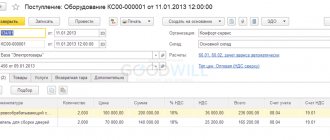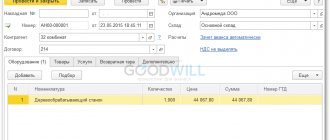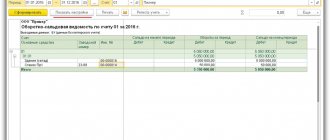Any receipt of an object of fixed assets (F), whether it be a purchase, gratuitous transfer or acquisition in exchange, entails the mandatory determination of a depreciation group, which is assigned based on the useful life of the property. It is during this period that the cost of the property gradually becomes part of the company's costs. Write-off of accrued depreciation amounts is carried out in one of four ways that are relevant for accounting established in the accounting policy of a particular enterprise.
Shock absorption groups
When registering, PF objects are assigned to a specific depreciation group. There are 10 of them in total; they are listed in the OS Classification by depreciation groups. The main criterion for combining units of property into any of the depreciation categories is the useful life (USI) of the object. It is determined by enterprises for each PF facility, based on the expected useful period, operating conditions and regulations governing the use of the property.
SPI is the main criterion for classifying an asset into one of the presented depreciation groups.
| Group | SPI property |
| 1 | From 1 year to 2 years |
| 2 | From 2 to 3 years |
| 3 | From 3 to 5 years |
| 4 | From 5 to 7 years |
| 5 | From 7 to 10 years |
| 6 | From 10 to 15 years |
| 7 | From 15 to 20 years |
| 8 | From 20 to 25 years |
| 9 | From 25 to 30 years |
| 10 | Over 30 years |
According to the general rules, the organization depreciates the received asset over the period of fixed income, determined by the Classifier (see table). If the company cannot find an object on the list, then the deadline is set based on the specifications of the asset or the manufacturer’s recommendations. If the asset is manufactured in a company, then the company’s specialists independently develop recommendations confirming the effective life of the asset. They are drawn up in any form. This may be an order from the manager or another document defining the PPI of the asset. Let's consider the characteristic features of property classified in each depreciation group.
Fifth group of classification of fixed assets
- OKOF
- Shock absorption groups
- Fifth group
Property with a useful life of over 7 years up to 10 years inclusive.
Determination of depreciation group and useful life using the OKOF code:
| Code OKOF | Name | Note |
| Building | ||
| 210.00.00.00.000 | Buildings (except residential) | prefabricated and mobile buildings |
| Facilities and transmission devices | ||
| 220.41.20.20.300 | Constructions of fuel and energy, metallurgical, chemical and petrochemical enterprises | except for radar and radio navigation equipment of fixed assets included in other groups |
| 220.41.20.20.303 | Thermal main network | |
| 220.41.20.20.318 | Absorption complex gas treatment plant | |
| 220.41.20.20.500 | Forest industry buildings | metal floating forest retention, forest guide, fencing and mooring structures |
| 220.41.20.20.650 | Facilities for agricultural production | livestock buildings |
| 220.41.20.20.700 | Facilities for the construction industry, transport and communications | port transshipment complex for processing general perishable cargo |
| 220.41.20.20.719 | Park of metal vertical cylindrical tanks | |
| 220.41.20.20.902 | Industrial sites without coatings | |
| 220.41.20.20.903 | Production sites with coatings | |
| 220.42.11.10.122 | Automobile road with an improved lightweight or transitional type of road surface | |
| 220.42.99.11.190 | Objects specialized for the manufacturing industry, not included in other groups | electric furnace |
| cars and equipment | ||
| 320.26.30.11.150 | Radio-electronic communications | special technological equipment for the production of electronic and radio equipment, except for radar and radio navigation equipment included in other groups |
| 330.25.30 | Steam boilers, except hot water central heating boilers | heating boilers, water heaters and auxiliary equipment for them |
| 330.25.30.1 | Steam boilers | |
| 330.25.30.12 | Auxiliary equipment for use in conjunction with steam boilers; condensers for steam-water or other steam power plants | capacitors |
| 330.25.30.12.110 | Auxiliary equipment for use in conjunction with steam boilers | |
| 330.26.51 | Equipment for measurement, testing and navigation | laboratory enrichment equipment; instruments for scientific research (meteorological and aerological instruments, hydrological, hydrometeorological, for field geophysical research in wells, geological and hydrogeological, drilling process control system equipment) |
| 330.26.51.53 | Instruments and equipment for physical or chemical analysis, not included in other groups | specialized technological equipment for the production of electrical products and materials |
| 330.26.51.6 | Other instruments and instruments for measurement, control and testing | filling, pressure testing and drainage equipment for testing pipelines; measuring instruments for general use, except for control equipment for technological processes |
| 330.26.51.66 | Instruments, instruments and machines for measurement or control, not included in other groups | equipment and devices specialized for automation of technological processes |
| 330.28.11.21.190 | Other steam turbines | |
| 330.28.11.23 | Gas turbines, except turbojet and turboprop | |
| 330.28.12.1 | Hydraulic and pneumatic power equipment | except for pneumatic drive devices |
| 330.28.2 | Other general purpose machinery and equipment | air separation and rare gas installations |
| 330.28.21.13.119 | Other industrial or laboratory electric furnaces and chambers, not included in other groups | furnaces for chemical production with rotating drums; tubular furnaces |
| 330.28.21.13.129 | Other induction or dielectric heating equipment, not included in other groups | |
| 330.28.22.11.190 | Lifts not included in other groups | elevators, specialized equipment, except for lifting and transport for construction, equipment for lifting and transport machines |
| 330.28.22.14.160 | Stacker cranes | |
| 330.28.22.14.162 | Electric rack stacker cranes | |
| 330.28.22.15.120 | Other loaders | except forklifts |
| 330.28.22.18 | Lifting, transporting and other loading and unloading equipment | other equipment for transporting goods, except conveyors |
| 330.28.22.18.180 | Loading and unloading equipment for rolling mills, not included in other groups | equipment for drawing, drawing and rolling, cutting, straightening; a set of working machines and equipment for the workshop for the production of iron powders by spraying; working machines and equipment for ferroalloy slag separation shops; electrolyzers and service machines |
| 330.28.22.18.270 | Equipment for loading blast furnaces | machines and mechanisms for wet coke quenching; machines and mechanisms of coke ovens |
| 330.28.23.13.140 | Ticket printing machines | equipment and devices specialized for automation of technological processes |
| 330.28.29 | Other general purpose machinery and equipment, not included in other groups | internal combustion engines, except engines for vehicles; AC electric motors with a power of 0.25 kW and above (except for special power and large-sized ones); special power electric motors; except for fixed assets included in other groups |
| 330.28.30 | Machinery and equipment for agriculture and forestry | technological equipment for the peat industry |
| 330.28.30.2 | Other tractors for agriculture | |
| 330.28.30.54.110 | Machines for harvesting and primary processing of potatoes | |
| 330.28.30.54.120 | Machines for harvesting and primary processing of beets and other root crops | |
| 330.28.30.59.111 | Combine harvesters | |
| 330.28.30.59.120 | Machines for harvesting and primary processing of corn | |
| 330.28.41.3 | Other metalworking machines | turning groups, drilling and boring groups, gear cutting, milling groups; planing and slotting; bolt- and nut-threading; cutting machines, special and specialized |
| 330.28.41.31 | Bending, edge bending and straightening machines for metal processing | |
| 330.28.41.33 | Forging or stamping machines and hammers; hydraulic presses and presses for metal processing, not included in other groups | |
| 330.28.49 | Other machines | technological equipment for the glass-sitall industry; specialized technological equipment for the production of electric lamps |
| 330.28.49.1 | Machines for working stone, wood and similar hard materials | |
| 330.28.49.11 | Machines for working stone, ceramics, concrete or similar minerals | |
| 330.28.49.12.130 | Electroplating Equipment | |
| 330.28.91.11 | Converters, ladles, molds and casting machines; rolling mills | cold and hot sheet cutting units |
| 330.28.91.11.150 | Rolling mills for metallurgical production | casting and rolling units |
| 330.28.92.30 | Other excavation and construction machines | specialized machines, mechanisms, equipment and small-scale mechanization for the construction and overhaul of main pipelines; technological equipment for the production of building materials |
| 330.28.92.40.110 | Machines for sorting, screening, separating or washing soil, stone, ore and other minerals | filters for coal and ore concentrates and sludges |
| 330.28.93 | Equipment for the production of food, beverages and tobacco products | |
| 330.28.95.11 | Equipment for the production of paper and cardboard | machines and equipment for pulp and paper, printing, for the processing of polymer materials and the production of rubber products |
| 330.28.99.39.110 | Launch equipment for aircraft | |
| 330.29.10.59.140 | Firefighting vehicles | |
| 330.29.10.59.141 | Firefighting vehicles for extinguishing fires with water | |
| 330.29.10.59.142 | Firefighting vehicles for extinguishing fires with special fire extinguishing agents | |
| 330.29.10.59.143 | Firefighting vehicles for combined extinguishing of large fires | |
| 330.29.10.59.144 | Firefighting ladders and vehicle lifts | |
| 330.30.20.31.112 | Ballast cleaning and dosing machines | |
| 330.30.20.31.113 | Machines for assembling, laying and dismantling track grids | |
| 330.30.20.31.115 | Machines for clearing paths of snow, debris and vegetation | vegetation destruction machines |
| 330.30.20.31.117 | Power and track welding machines and units | autonomous power supply sources, except for fixed assets included in other groups; energy power units |
| 330.30.20.31.120 | Track equipment for monitoring and repair of railway tracks | test equipment for checking devices; raillayers |
| 330.30.20.31.129 | Equipment and mechanisms for repairing narrow gauge tracks | |
| 330.32.99.53 | Instruments, equipment and models intended for demonstration purposes | musical instruments |
| Means of transport | ||
| 310.29.10.23 | Vehicles with a piston internal combustion engine with compression ignition (diesel or semi-diesel), new | electrical equipment of vehicles with internal combustion engines or diesel engines |
| 310.29.10.24 | Other vehicles for transporting people | Large class passenger cars (with engine capacity over 3.5 liters) and high class |
| 310.29.10.30.119 | Other buses | especially large buses (bus trains) with a length of over 16.5 to 24 m inclusive |
| 310.29.10.41.112 | Trucks with a diesel engine having a technically permissible maximum weight of more than 3.5 tons, but not more than 12 tons | |
| 310.29.10.41.113 | Trucks with a diesel engine having a technically permissible maximum weight exceeding 12 tons | |
| 310.29.10.42.112 | Trucks with a gasoline engine having a technically permissible maximum weight of more than 3.5 tons, but not more than 12 tons | |
| 310.29.10.42.113 | Trucks with a gasoline engine and having a technically permissible maximum weight exceeding 12 tons | |
| 310.29.10.5 | Special purpose vehicles | truck tractors |
| 310.29.10.59.270 | Vehicles equipped with lifts and working platforms | auto hydraulic lifts |
| 310.29.10.59.390 | Other special-purpose motor vehicles, not included in other groups | garbage trucks |
| 310.29.20.23 | Other trailers and semi-trailers | |
| 310.30 | Other transport vehicles and equipment | diving equipment and property |
| 310.30.11.24 | Dry cargo ships | only dry-cargo vessels of mixed navigation "river-sea" |
| 310.30.12.19 | Other pleasure or sports vessels; rowing boats, dinghies and canoes | except for recreational and sports crafts |
| 310.30.20.12.130 | Narrow gauge diesel locomotives | |
| 310.30.20.13.111 | Steam locomotives | narrow gauge steam locomotives |
| 310.30.20.20.120 | Passenger tram cars, self-propelled (motor) | |
| 310.30.20.33.140 | Tram freight cars | |
| Industrial and household equipment | ||
| 520.00.10.04 | Perennial plantings of hops, essential oil crops, medicinal crops | |
| 520.00.10.08 | Other cultivated resources of plant origin, repeatedly producing products, not included in other groups | lemon; orange; chokeberry |
| Fixed assets not included in other groups | ||
| 230. 00.00.00 | Expenses for land improvement | |
| 400.00.10.04 | Other weapons | dual-use sports weapons, hunting and military equipment |
| 400.00.50 | Equipment for take-off, landing and maintenance of aircraft | |
| 790.00.90.09 | Other intellectual property | |
What is depreciation
In accounting, depreciation is calculated according to the rules established by paragraphs 17-25 of PBU 6/01, approved by Order of the Ministry of Finance of the Russian Federation dated March 30, 2001 No. 26n (hereinafter referred to as PBU 6/01). Depreciation is the process of monthly transferring the cost of fixed assets to the costs of the current period. That is, by calculating depreciation, the cost of property assets is transferred to the cost of manufactured products (work performed, services provided), in other words, repaid (clause 17 of PBU 6/01).
In accordance with clause 49 of the Guidelines for accounting of fixed assets, approved by Order of the Ministry of Finance of the Russian Federation dated October 13, 2003 No. 91n (hereinafter referred to as Guidelines No. 91n), is subject to depreciation is :
- belongs to the organization by right of ownership;
- are under the organization’s economic control (or operational management);
- leased by an organization (or trust management, free use).
Depreciation is calculated (clause 49 and clause 50 of Methodological Instructions No. 91n):
- organization - for fixed assets owned by it;
- by the lessor - for fixed assets leased out;
- by the tenant - for fixed assets included in the property complex under the lease agreement of the enterprise (in the same manner as for fixed assets owned by right of ownership);
- by the lessor or lessee - for fixed assets that are the subject of a financial lease agreement (depending on the terms of the agreement).
Depreciation is not accrued according to (paragraphs 2-5, paragraph 17 of PBU 6/01, paragraphs 2 and 3, paragraph 49 of Methodological Instructions No. 91n):
- objects for mobilization purposes (mothballed and not used in the organization’s activities);
- objects of non-profit organizations (for such objects, depreciation is accrued using a linear method, which is recorded in off-balance sheet account 010 “Depreciation of fixed assets”);
- housing assets (residential buildings, dormitories, etc.), with the exception of those related to profitable investments in material assets (i.e., accounted for in account 03 and used to generate income);
- objects whose consumer properties remain unchanged over time (land plots, environmental management objects, objects classified as museum objects and museum collections, etc.).
Key aspects
Payers of the property tax of organizations are recognized as all legal entities that have chosen the main taxation regime, as well as those who own assets classified as taxable.
Officials have identified an exhaustive list of objects that form the tax base for this fiscal obligation. This list of property assets is enshrined in Article 374 of the Tax Code of the Russian Federation. Also, this article of the code, namely paragraph 4, defines property that is not recognized as taxable objects. Thus, among the exempt assets are listed fixed assets assigned to the first and second depreciation groups.
In addition, officials noted that if the taxpayer’s property is only non-taxable objects, then they are not payers of the property tax of organizations. This means that they are not required to calculate and pay the tax to the budget. Such economic entities do not have to submit tax returns and advance calculations for fiscal obligations to the Federal Tax Service.





